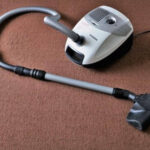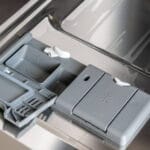It is a jolly afternoon but you decide to part ways with your snuggly throw blanket or cozy couch anyway, to go for a clothes shopping spree. After all, leaving the house isn’t way too much effort for a task as satisfying. You end up in one of the well or fairly known brick and mortar stores, or favorite thrift store and take back home a nice sweater, blouse or pair of eye-catching pants.
In a few days, you wear the piece of clothing and before you know it, it is time to rescue it from your laundry basket. And how do you do this? Washing of course. But because you know how easily you can ruin the precious piece by ignoring seemingly trivial steps, you decide take a closer look at the care label.
Here, you come across a symbol you do not really understand, followed by the phrase “dry flat”. Since you are used to throwing everything into the washer and tumble dryer thereafter, you begin pondering about what it means to dry flat.
What Does Dry Flat Mean?

Dry flat simply means that you spread a garment of a flat surface to air or sun dry after washing it. Some clothing care labels might provide more specific instructions such as “dry flat on shade”. This means that you should spread the garment on a flat surface under a shade or indoors.
A flat surface can be a drying rack designed to serve that purpose, or it can be a table or any other clean flat surface that you have in your home. A drying rack works best because it has spaces in between the wires or metal rods, to allow your pieces of clothing to drip water to the surface so that they can dry quickly.
When the care tag says “dry flat” it is good to avoid entertaining the thought of putting the garment into a dryer or hanging it. Remember that permanent damage is a hefty price to pay for a garment you are not ready to bid goodbye.
A dryer produces heat, which can ruin the fabric by causing shrinkage. Even so, some dry flat clothes are made of fabrics that cannot shrink in the dryer. Of course this only rakes your brain more as to why you should not use it then. Well! Besides heat, another common problem with drying clothes in the dryer is that it can speed up fabric pilling. Lastly, the tumbling action does not always go well with some clothing items.
Hanging clothes that are for drying flat on the other hand has its share of challenges for some fabrics. For fabrics that have a 2-way stretch, you might end up with larger garments depending on how you hang clothes. And as for fabrics with a 4-way stretch, you might end up with wider and longer garments. Another likely problem is to end with misshapen clothes around the areas you secure the garments to lines with clothespins.
But you might feel so smart and think of using a hanger to hang a dry flat garment on the clothesline. Perhaps this might help in some cases. However, you will not like the results if you pull the move with some of your wool or cashmere sweaters.
Sometimes you might be lucky and have the care label explain briefly what is likely to happen if you place your garment in the dryer or hang it. This way, you do not have to keep guessing.
The Dry Flat Symbol

The dry flat symbol is basically a box with a small dash in the inside. If the care tag on the garment has this symbol only, then you should automatically know that dry flat is the recommended method for drying.
Can you Put Dry Flat Clothes in the Dryer?
If you totally dread the idea of flat drying clothes even when the instructions say so, it might be hard to resist the temptation of drying them in a tumble dryer. Interestingly, some people swear by incredible results from doing this repeatedly with some of their garments.
All the same, it is advisable that you do not try this with a garment you are not ready to let go. Otherwise, you might be setting yourself up for a heartbreak.
How about tumble drying on low?
This is still not a great choice for dry flat clothes but it is better than drying on higher heat dryer settings.
How to Dry Flat Clothes
Drying flat isn’t exactly the most space-efficient drying method. If you wash ten clothes that require to dry flat at ago, you might as well need a quarter acre of spreading space. Wait! And God knows how many racks or tables you will need.
So, before you even think about drying, it is best to spread your dry flat garment across multiple washes so that you can have ample drying space.
Secondly, the dry flat method is slower than a tortoise. Bear this in mind when washing and preparing your clothes for drying. If your garment is machine washable, run it through the fastest spin cycle. This is the most effective cycle for removing water from clothes. If handwashing your garment, wring it properly so that it can dry quickly.
Regardless, it is important to have in mind that you should not squeeze out water from some fabrics. You can sometimes find this kind of information on the care label.
If the plan is to spread your clothes flat on a rack, place the rack in a place where you are comfortable with water dripping on the surface. If you are using a table, you might want to spread a towel or white cloth before spreading the garment.
If you should dry flat your garment under a shade, ensure that the flat surface you are using is under a shade or indoors. Turn the garment inside out before spreading it. This prevents it from fading quickly incase the material is colorfast.
Spread the garment well and allow it to dry for about 2 hours then turn it over. Let it dry completely on both sides.
Common Clothes to Dry Flat
Wool and cashmere sweaters: You have no choice but to dry flat anything that belongs to these categories. Gambling with any other drying method leaves these type of clothes looking overstretched or shrunken haphazardly.
Rayon clothes: This is another fabric you don’t want to taken chances with especially when it comes to the dryer. You can try your luck with hanging but stick to drying flat for best results.
Knitted clothes: Anything that is knitted will simply lose its shape at least to some extent if you hang dry it or throw it into the tumble dryer. Preserve its shape by laying it flat to dry.





